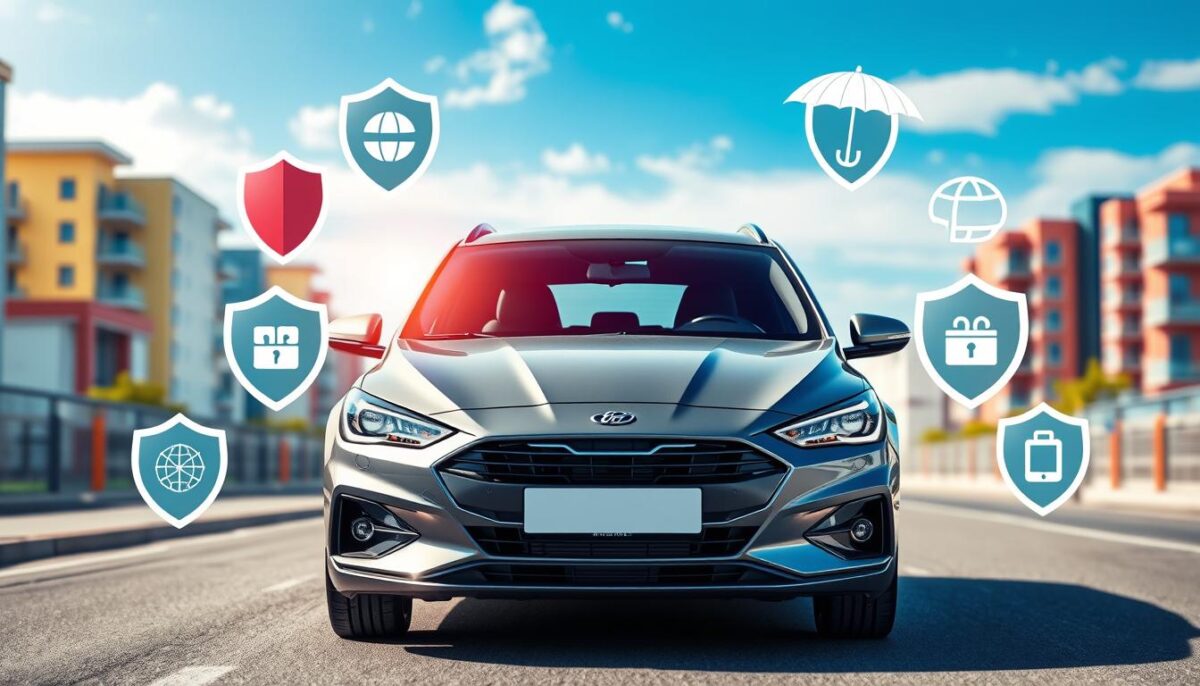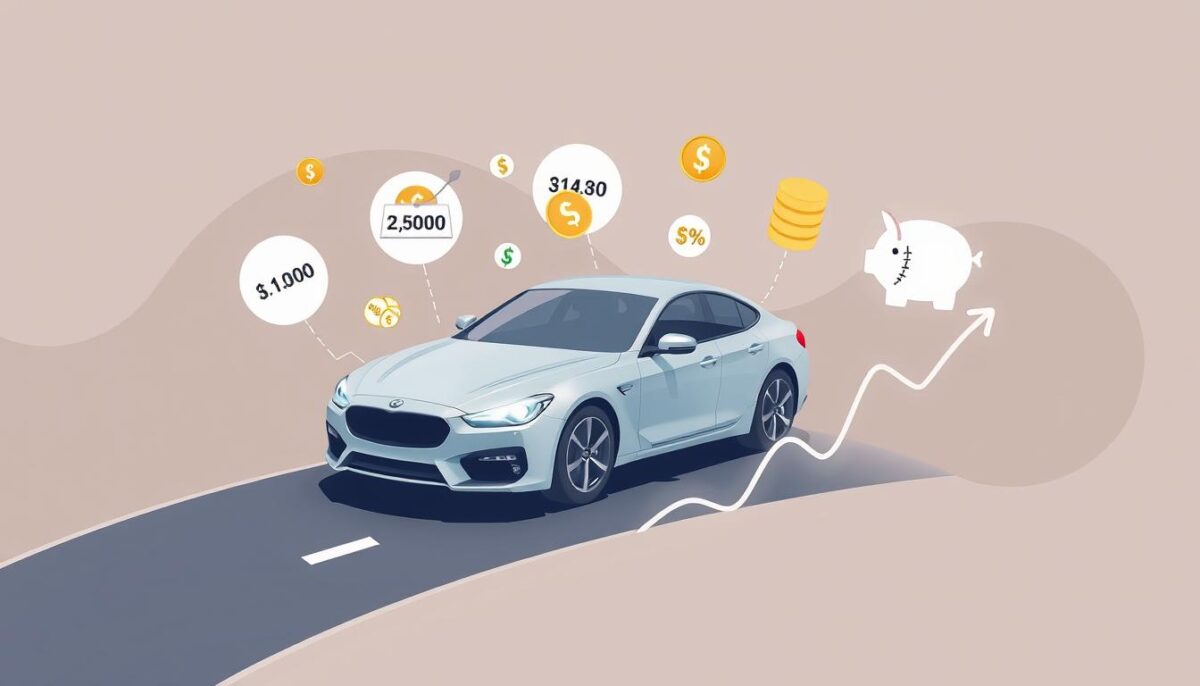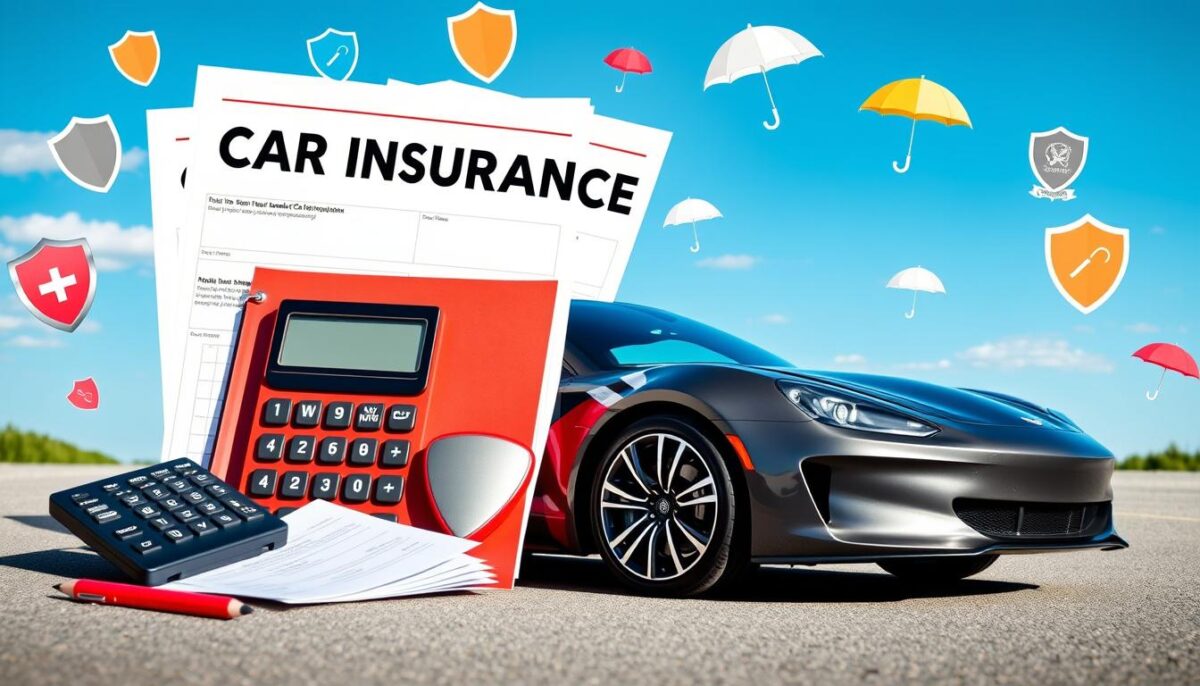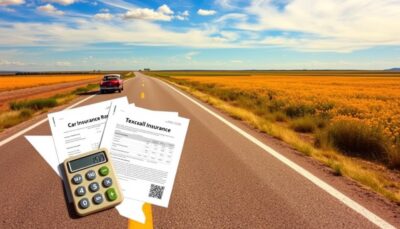Finding the right car insurance can seem hard. But, getting full coverage is key to protect your car and money. This guide will show you the top find full coverage car insurance options. We’ll help you choose wisely for your safety.
Full coverage car insurance includes many types of protection. It has liability, collision, and comprehensive coverage. Knowing what full coverage offers and what affects its price helps you get the best for you.
Key Takeaways
- Full coverage car insurance provides comprehensive protection for your vehicle and financial well-being.
- Exploring the different types of coverage and understanding your specific needs can help you find the right full coverage plan.
- Factors like vehicle type, driving history, and location can impact the cost of full coverage car insurance.
- Comparing insurance providers, taking advantage of discounts, and reviewing your policy regularly can help you find affordable full coverage options.
- Consulting with insurance professionals can ensure you get the proper coverage and understand your policy details.
Understanding Full Coverage Car Insurance
Car insurance can seem complex, but knowing about full coverage is key. It offers comprehensive coverage, collision coverage, and liability protection. This combination provides strong protection for drivers.
Definition of Full Coverage
find full coverage car insurance goes beyond the minimum legal requirements. It also protects your vehicle from damage. If an accident happens, your insurance will help pay for repairs or a new car. It also covers any claims from the other party.
Key Components of Full Coverage
- Comprehensive Coverage: This part of the policy covers non-collision damages like theft, vandalism, or natural disasters.
- Collision Coverage: It pays for fixing or replacing your car if you crash into something else.
- Liability Protection: This part keeps you safe from financial loss if you’re at fault in an accident. It covers injuries or property damage to others.
Common Misconceptions
Many people think full coverage means they’re covered for everything. But, it’s not true. There might be things not covered, like custom parts or very expensive cars. Always check your policy to know what’s included.
“Full coverage” is a term that can be misleading, as it doesn’t necessarily mean that every possible scenario is covered. Understanding the specific components of your policy is crucial.”
Reasons to Choose Full Coverage
Choosing find full coverage car insurance offers many benefits. It goes beyond the basic needs. It provides financial protection and peace of mind on the road.
Financial Protection Benefits
Full coverage helps protect you from the cost of accidents. It includes uninsured motorist coverage and comprehensive coverage. This means you’re covered, even if the other driver is uninsured or if your car is damaged by natural disasters or theft.
Peace of Mind While Driving
With full coverage, you can drive knowing you’re protected. This is especially important for those who travel a lot or drive in busy cities. These places have a higher risk of accidents.
Increased Vehicle Resale Value
Having full coverage also helps your car’s resale value. Buyers often look for cars that have been well-insured. This shows the car has been well-maintained and is less likely to have been damaged.
| Benefit | Description |
|---|---|
| Financial Protection | Full coverage insurance can shield you from the financial burden of costly repairs or medical expenses in the event of an accident. |
| Peace of Mind | Driving with the assurance of full coverage can provide a sense of security and peace of mind, particularly in high-risk situations. |
| Increased Resale Value | Maintaining a comprehensive insurance policy can enhance the resale value of your vehicle, as it demonstrates the car has been well-protected. |

Full coverage car insurance is a smart choice. It offers financial security and peace of mind. This makes driving safer and more confident.
Factors Influencing Full Coverage Costs
Several factors can affect the cost of find full coverage car insurance. Insurance companies look at the vehicle’s type and age, the driver’s history, and where the car is mainly used. Let’s dive into these important factors.
Vehicle Type and Age
The make, model, and year of your car greatly influence your car insurance rates. Newer, pricier cars usually cost more to insure because of repair and replacement costs. Also, certain cars, like sports cars or luxury models, are seen as riskier. This can make your premiums higher.
Driving History Impact
Your driving record is key in setting your full coverage costs. A clean record with no accidents or tickets can get you better car insurance rates. But, a record with accidents or tickets can make you seem riskier. This can lead to higher auto insurance quotes.
Location Considerations
Where you live also affects your insurance costs. Things like population density, crime rates, and accident frequency in your area matter. Urban areas usually have higher car insurance rates than rural or suburban ones.
| Factor | Impact on Full Coverage Costs |
|---|---|
| Vehicle Type and Age | Newer, more expensive vehicles and high-performance models typically have higher car insurance rates. |
| Driving History | A clean driving record with no accidents or violations can lead to lower auto insurance quotes. |
| Location | Urban and metropolitan areas generally have higher car insurance rates compared to rural or suburban locations. |
Knowing what affects full coverage costs helps you make better choices. You can find the right coverage that fits your needs and budget.
How to Determine the Right Amount of Coverage
Choosing the right find full coverage car insurance can be tricky. But it’s key to protect yourself and your vehicle. We’ll help you figure out what you need by looking at your coverage needs, personal risks, and talking to insurance experts.
Assessing Your Coverage Needs
Start by thinking about what you need. Look at your vehicle’s value, how you drive, and how far you travel. These details help you choose the right liability, collision, and comprehensive coverage.
Evaluating Risk Factors
It’s also important to think about your personal risks. Check your driving record, local accident rates, and the chance of theft or natural disasters. Knowing these risks helps you decide on the right coverage.
Consulting Insurance Professionals
Getting advice from insurance experts is a smart move. They can look at your situation, suggest coverage levels, and find affordable options. This way, you get the best coverage for your budget and needs.

By following these steps, you can find the right car insurance coverage. It’s all about balancing liability protection and comprehensive coverage. This ensures you’re ready for anything on the road.
Exploring Different Types of Coverage
Understanding find full coverage car insurance is key. Let’s look at the main parts of a policy. They help keep you safe while driving.
Liability Coverage
Liability coverage is the base of a full coverage policy. It protects you if you’re at fault in an accident. It covers medical costs, property damage, and legal fees.
Collision and Comprehensive Coverage
Collision coverage helps when your car is damaged in an accident. It covers repairs or a new car. Comprehensive coverage protects against theft, vandalism, or natural disasters.
Uninsured/Underinsured Motorist Coverage
Uninsured motorist coverage helps if the other driver has no insurance. Underinsured motorist coverage helps if their insurance is not enough.
These are key parts of a full coverage policy. Knowing about them helps you choose the right policy. This ensures you’re well-protected on the road.
Comparing Insurance Providers
Finding the right full coverage auto insurance policy is key. We need to compare top insurers, read customer reviews, and check their claim handling. This helps us choose a policy that protects us financially and gives us peace of mind.
Top Insurers in the Market
The auto insurance market is competitive. Companies like State Farm, Geico, Progressive, Allstate, and Nationwide lead the way. They offer a range of full coverage options to fit different drivers’ needs.
Customer Reviews and Ratings
Customer feedback is crucial when picking an auto insurance provider. Reviews from J.D. Power, the Better Business Bureau, and Trustpilot offer insights into service quality and satisfaction. This helps us make a smart choice.
Claim Handling Efficiency
How well an insurer handles claims is a key test. Quick and efficient claims processing helps us get back on the road fast. We should look into each insurer’s claim process, how long it takes, and how satisfied customers are.
| Insurer | Customer Satisfaction Rating (J.D. Power) | Average Claim Processing Time |
|---|---|---|
| State Farm | 4.5 out of 5 | 12 days |
| Geico | 4.2 out of 5 | 9 days |
| Progressive | 4.1 out of 5 | 11 days |
| Allstate | 3.9 out of 5 | 15 days |
| Nationwide | 3.7 out of 5 | 14 days |
By comparing insurance providers, we can find the best full coverage auto insurance. This ensures we get the protection and peace of mind we need on the road.
Discounts and Savings Opportunities
Looking for affordable car insurance? Check out the discounts and savings you can get. You can save by bundling policies, being a safe driver, or driving less. These options can help lower your insurance costs and give you full coverage.
Bundling Insurance Policies
One smart way to save is by bundling your car insurance with other policies. Homeowner’s or renter’s insurance can be bundled for a discount. This can lead to big savings and make managing your policies easier.
Safe Driver Discounts
Driving safely can save you a lot on insurance. Insurance companies give discounts to safe drivers. If you have no accidents or tickets, you’re more likely to get these discounts.
Discounts for Low Mileage
Driving less can also get you discounts. Insurance companies see low-mileage drivers as lower risk. By telling your provider how much you drive, you might save money on insurance discounts and affordable car insurance.
| Discount Type | Potential Savings | Eligibility Criteria |
|---|---|---|
| Bundling Insurance Policies | Up to 25% off | Combining car insurance with other policies (e.g., homeowner’s, renter’s) |
| Safe Driver Discounts | Up to 20% off | Clean driving record with no at-fault accidents or moving violations |
| Low Mileage Discounts | Up to 15% off | Driving less than 7,500 miles per year |
By using these insurance discounts, you can make your affordable car insurance even better. It’s all about finding ways to save and get the most value for your money.
The Role of Deductibles in Full Coverage
Deductibles are a key part of car insurance. They are the amount you pay before your insurance helps. Knowing about deductibles can help you save money and get better protection.
Understanding Deductibles
Deductibles are a way for you and your insurance to share costs. If you choose a higher deductible, you’ll pay less each month. But, if you pick a lower deductible, your premiums will be higher. It’s a trade-off to think about when picking your coverage.
Choosing the Right Deductible
Finding the right deductible depends on your money situation and how much risk you’re okay with. A higher deductible means lower car insurance rates. But, make sure you can afford it if you need to make a claim. Finding a balance between cost and readiness is important.
How Deductibles Affect Premiums
The more you pay for your deductible, the less you’ll pay for affordable car insurance. This is because your insurance company takes on less risk. On the other hand, a lower deductible means higher premiums because your insurance company takes on more risk.
| Deductible Amount | Average Monthly Premium |
|---|---|
| $250 | $100 |
| $500 | $80 |
| $1,000 | $60 |
The table shows how deductibles affect your monthly car insurance costs. Choosing a higher deductible can save you a lot of money on car insurance rates.

“Selecting the right deductible is a critical decision that can have a long-lasting impact on your financial well-being and the cost of your car insurance coverage.”
The Importance of Regular Policy Review
In the world of car insurance, it’s key to regularly check and update your policy. Life changes, market trends, and new coverage needs can affect your current insurance. By staying on top of these changes, you can get the best rates and coverage.
Evaluating Life Changes
Life brings many changes that can impact your insurance needs. A new job, moving, or adding a new car can all change what you need. Regularly reviewing your policy helps you adjust to these changes and stay protected.
Keeping Up with Market Trends
The car insurance world is always changing. New products, discounts, and options come out all the time. Staying informed helps you keep your policy up to date. This might mean looking at new providers, trying new coverages, or finding ways to save.
Adjusting Coverage as Needed
As your life changes, so might your insurance needs. Maybe you got a new car or your driving record improved. Regular policy reviews help you adjust to these changes. This ensures your coverage fits your needs and protects your finances.
In conclusion, reviewing your car insurance policy regularly is very important. Being proactive and adaptable helps you get the best coverage and enjoy peace of mind. Your insurance is a vital safety net, and it’s worth the effort to make sure it’s working well.
Remember, your car insurance is a crucial safety net. It’s important to take the time to review your policy. This way, you can be sure you’re getting the best value and protection on the road.
Tips for Finding Affordable Full Coverage
Finding affordable full coverage car insurance is a top priority for many drivers. To achieve this goal, we recommend following these practical tips:
Shopping Around for Quotes
The key to finding the best rates is to shop around and compare quotes from multiple insurance providers. Don’t settle for the first offer you receive – take the time to explore auto insurance quotes from a variety of reputable companies. This will help you identify the most competitive options and ensure you’re getting the coverage you need at the right price.
Utilizing Comparison Tools
Online insurance comparison tools can greatly simplify the quote-gathering process. These platforms allow you to input your information and quickly receive side-by-side comparisons of coverage options and pricing from multiple insurers. Leveraging these user-friendly tools can save you significant time and effort in your search for affordable full coverage.
Negotiating with Insurance Agents
When you’ve narrowed down your options, don’t be afraid to negotiate with insurance agents. They may be willing to offer additional discounts or adjust coverage levels to meet your needs. By approaching the conversation with a polite and professional demeanor, you can often secure more favorable terms and pricing.
By following these tips, you’ll be well on your way to finding affordable full coverage car insurance that provides the financial protection and peace of mind you deserve on the road.
| Insurer | Average Annual Premium | Customer Satisfaction | Claims Handling |
|---|---|---|---|
| Geico | $1,200 | 4.5/5 | 4.7/5 |
| State Farm | $1,400 | 4.3/5 | 4.6/5 |
| Progressive | $1,150 | 4.2/5 | 4.4/5 |
| Allstate | $1,300 | 4.1/5 | 4.3/5 |
Next Steps After Finding Full Coverage
Congratulations on finding the right full coverage car insurance policy. The next step is to finalize the policy details. This ensures you understand your coverage fully.
This understanding will help you get the most value from your insurance. It also provides the protection you need on the road.
Finalizing Your Policy
After choosing your insurance provider and coverage, it’s time to apply. You might need to submit more documents, sign forms, and pay the first premium. Work closely with your agent to make sure everything is correct.
This way, your policy will be ready to start protecting you.
Understanding Your Policy Details
Take time to review your insurance policy documents carefully. Learn about the coverage limits, deductibles, and any exclusions. Knowing this will help you during the claims process.
It ensures you’re making the most of your full coverage protection.
Staying Informed About Coverage Options
The car insurance industry is always changing. New coverage options and discounts appear regularly. It’s important to review your policy often.
By doing this, you can enhance your protection or find ways to save money. Keeping in touch with your insurance provider is key. This way, you can adjust your coverage as your needs change.
FAQ
What is full coverage car insurance?
Full coverage car insurance includes comprehensive, collision, and liability protection. It offers broad financial protection in case of accidents, theft, or other incidents.
What are the key components of full coverage car insurance?
Full coverage car insurance has three main parts:
– Comprehensive coverage protects against theft, vandalism, or natural disasters.
– Collision coverage pays for repairs or replacement if you’re in an accident.
– Liability coverage helps if you’re legally responsible for damages or injuries to others.
What are the benefits of choosing full coverage car insurance?
Choosing full coverage car insurance offers several benefits:
– Provides comprehensive financial protection in case of accidents or other incidents.
– Gives us peace of mind and security while driving.
– Can also increase our vehicle’s resale value due to comprehensive coverage.
What factors influence the cost of full coverage car insurance?
Several factors can affect the cost of full coverage car insurance:
– The type and age of your vehicle.
– Your driving history and record.
– The location where you live and garage your vehicle.
How can we determine the right amount of full coverage for our needs?
To find the right amount of full coverage, consider:
– Assessing your personal coverage needs and risk factors.
– Evaluating how much financial protection you need.
– Getting advice from insurance professionals for personalized recommendations.
What types of coverage are included in a full coverage car insurance policy?
A full coverage car insurance policy includes:
– Liability coverage for damages or injuries to others.
– Collision coverage for repairs or replacement after an accident.
– Comprehensive coverage for non-collision damages like theft or vandalism.
– Uninsured/Underinsured motorist coverage for accidents with drivers without insurance.
How can we compare insurance providers for full coverage car insurance?
When comparing insurance providers, consider:
– The reputation of top insurers.
– Customer reviews and ratings.
– How efficiently they handle claims and their customer service.
What types of discounts and savings opportunities are available for full coverage car insurance?
Discounts for full coverage car insurance include:
– Bundling with other policies like homeowner’s or renter’s insurance.
– Safe driver discounts for a clean driving record.
– Discounts for low annual mileage or usage-based insurance programs.
How do deductibles affect the cost of full coverage car insurance?
Deductibles greatly impact the cost of full coverage car insurance. A higher deductible means lower premiums but higher out-of-pocket costs. A lower deductible means higher premiums but less out-of-pocket costs. Choose a deductible that fits your financial situation and risk tolerance.
Why is it important to regularly review our full coverage car insurance policy?
Regularly reviewing your full coverage car insurance policy is crucial. It ensures you have the best coverage and rates. This includes considering life changes, staying updated on market trends, and adjusting your policy as needed.
What are some tips for finding affordable full coverage car insurance?
To find affordable full coverage car insurance, try:
– Shopping around and comparing quotes from different insurers.
– Using online comparison tools to compare coverage and rates.
– Negotiating with insurance agents for better rates or discounts.
What are the next steps after finding the right full coverage car insurance policy?
After finding the right policy, the next steps are:
– Finalizing the policy details and understanding the coverage.
– Reviewing the policy documents and coverage limits carefully.
– Staying informed about any changes or updates to your coverage options.







